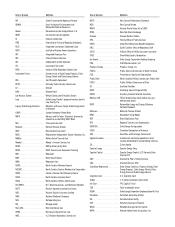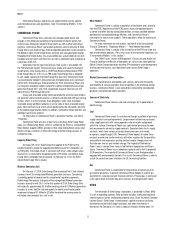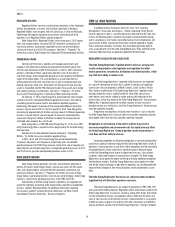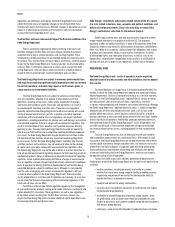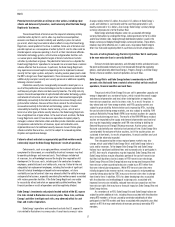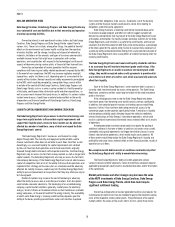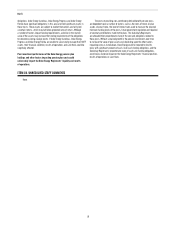Duke Energy 2013 Annual Report Download - page 29
Download and view the complete annual report
Please find page 29 of the 2013 Duke Energy annual report below. You can navigate through the pages in the report by either clicking on the pages listed below, or by using the keyword search tool below to find specific information within the annual report.
PART I
11
International Energy’s operations are subject to both country-specific
and international laws and regulations. (See “Environmental Matters” in this
section.)
COMMERCIAL POWER
Commercial Power owns, operates and manages power plants and
engages in the wholesale marketing and procurement of electric power, fuel
and emission allowances related to these plants as well as other contractual
positions. Commercial Power’s generation operations consist primarily of Duke
Energy Ohio’s coal-fired and gas-fired nonregulated generation assets located in
the Midwest region of the United States and wind and solar generation located
throughout the United States. The asset portfolio has a diversified fuel mix with
baseload and mid-merit coal-fired units as well as combined cycle and peaking
natural gas-fired units.
Generation from the coal-fired and gas-fired assets is dispatched into
the PJM wholesale market. These assets earn energy and capacity revenue at
market prices. Duke Energy Ohio is a PJM Fixed Resource Requirement (FRR)
entity through May 31, 2015. As an FRR entity, Duke Energy Ohio is obligated
to self-supply capacity for the Duke Energy Ohio load zone. Commercial Power
has economically hedged its forecasted coal-fired generation and a significant
portion of its forecasted gas-fired generation for 2014. Commercial Power also
has long-term economic hedges in place for a portion of expected coal and gas
generation through 2017 and 2018, respectively. Capacity revenues are 100
percent fixed in PJM through May 2017.
Energy and renewable energy credits generated by wind and solar projects
are generally sold at contractual prices. Contracts are executed with load serving
entities, which, in most instances, have obligations under state-mandated
renewable energy portfolio standards or similar state or local renewable energy
goals. Most contracts have a term which approximates the estimated useful life
of the underlying generation project. In addition, Commercial Power operates and
develops transmission projects.
For information on Commercial Power’s generation facilities, see Item 2,
“Properties.”
Commercial Power also has a retail sales subsidiary, Duke Energy Retail
Sales, LLC (Duke Energy Retail), which is certified by the PUCO as a Competitive
Retail Electric Supplier (CRES) provider in Ohio. Duke Energy Retail serves retail
electric and gas customers in Ohio with energy and other energy services at
competitive rates.
Capacity Rider Filing
On August 29, 2012, Duke Energy Ohio applied to the PUCO for the
establishment of a charge for capacity provided pursuant to its obligations as
an FRR entity. The charge, which is consistent with Ohio’s state compensation
mechanism, is estimated to be approximately $729 million, and reflects Duke
Energy Ohio’s embedded cost of capacity. On February 13, 2013, the PUCO
denied Duke Energy Ohio’s request.
Midwest Generation Exit
On February 17, 2014, Duke Energy Ohio announced that it had initiated
a process to exit its nonregulated Midwest generation business. Considering
a marketing period of several months and potential regulatory approvals,
Duke Energy Ohio expects to dispose of the nonregulated Midwest generation
business by early to mid-2015. In the first quarter of 2014, Duke Energy Ohio
will reclassify approximately $3.5 billion carrying value of its Midwest generation
business to assets held for sale and expects to record an estimated pretax
impairment charge of $1 billion to $2 billion to reduce the carrying value to
estimated sales proceeds less cost to sell.
Other Matters
Commercial Power is subject to regulation at the federal level, primarily
from the FERC. Regulations of the FERC govern access to regulated electric
customer and other data by nonregulated entities, services provided between
regulated and nonregulated energy affiliates, and Commercial Power’s
investments in transmission projects. These regulations affect the activities of
Commercial Power.
For more information on rate matters, see Note 4 to the Consolidated
Financial Statements, “Regulatory Matters — Rate Related Information.”
Commercial Power is subject to the jurisdiction of the EPA and state and
local environmental agencies. (For a discussion of environmental regulation, see
“Environmental Matters” in this section.)
See “Other Issues” section of Management’s Discussion and Analysis of
Financial Condition and Results of Operations for a discussion about potential
Global Climate Change legislation and other EPA regulations under development,
and the potential impacts such legislation could have on Duke Energy’s
operations.
Market Environment and Competition
The market price of commodities and services, along with the quality
and reliability of services provided, drive competition in the wholesale energy
business. Commercial Power’s main competitors include other nonregulated
generators and wholesale power providers.
Sources of Electricity
Commercial Power relies on coal and natural gas for its generation of
electric energy.
Coal
Commercial Power meets its coal demand through a portfolio of purchase
supply contracts and spot agreements. Large amounts of coal are purchased
under supply contracts with mining operators who mine both underground
and at the surface. Commercial Power uses spot-market purchases to meet
coal requirements not met by supply contracts. Expiration dates for its supply
contracts, which have various price adjustment provisions and market
re-openers, range through 2018. Commercial Power expects to renew these
contracts or enter into similar contracts with other suppliers for the quantities
and quality of coal required as existing contracts expire, though prices will
fluctuate over time as coal markets change. The majority of Commercial
Power’s coal is sourced from mines in the Northern Appalachian and Illinois
basins. Commercial Power has an adequate supply of coal to fuel its projected
2014 operations. The majority of Commercial Power’s coal-fired generation is
equipped with environmental controls. As a result, Commercial Power is able to
satisfy the current emission limitations for SO2 for existing facilities.
Gas
Commercial Power is responsible for the purchase of natural gas to its
gas turbine generators. In general Commercial Power hedges its natural gas
requirements using physical and financial contracts. Physical gas is purchased
in the spot market and under long-term contracts to meet generation needs.
OTHER
The remainder of Duke Energy’s operations is presented as Other. While
it is not an operating segment, Other primarily includes unallocated corporate
interest expense, certain unallocated corporate costs, Bison Insurance Company
Limited (Bison), Duke Energy’s wholly owned, captive insurance subsidiary,
contributions to the Duke Energy Foundation, and other investments in
businesses the Company is in various stages of exiting or winding down. On





